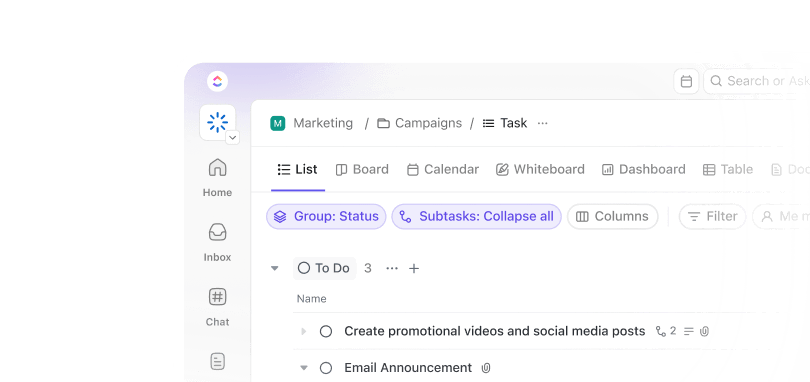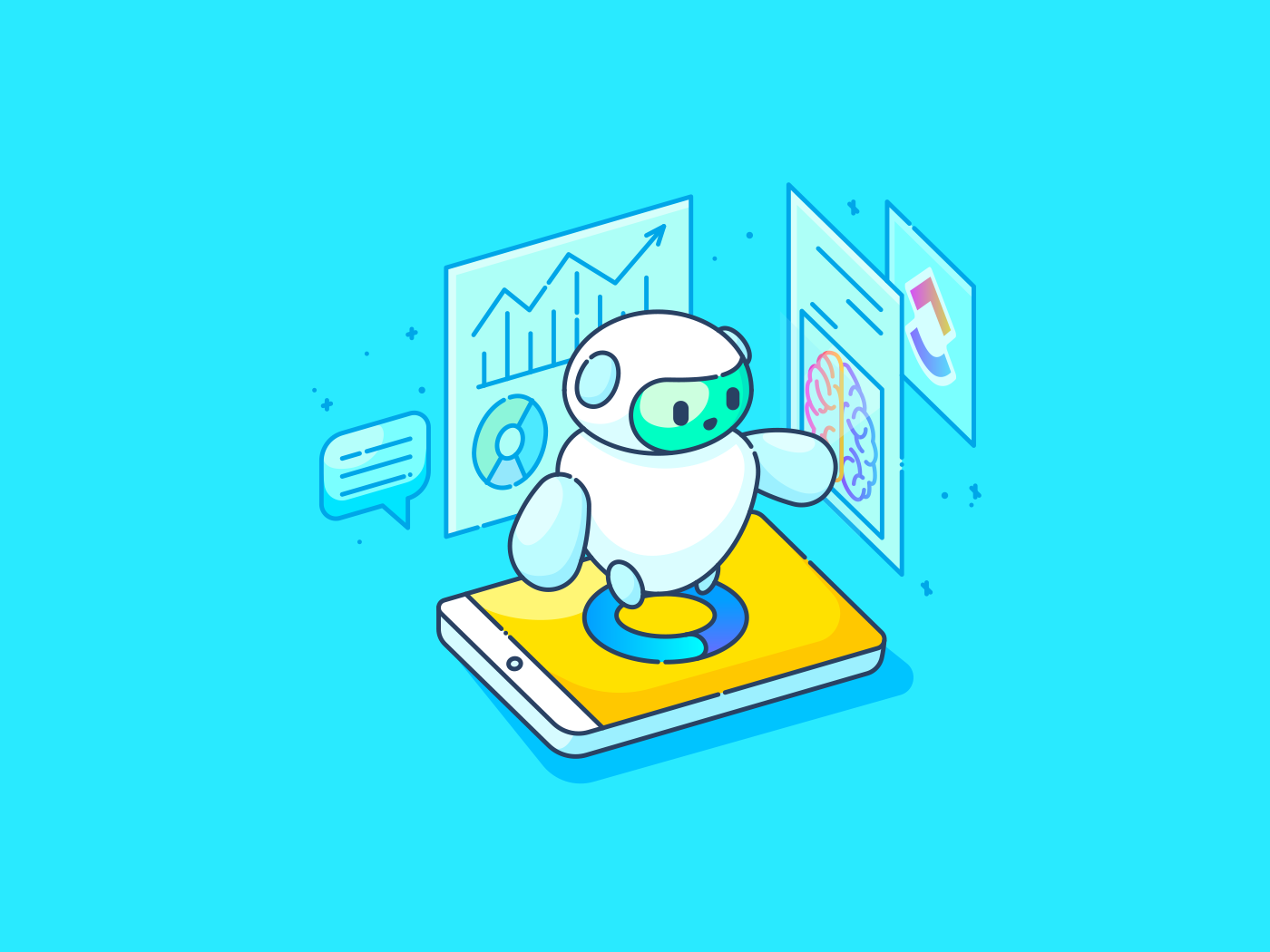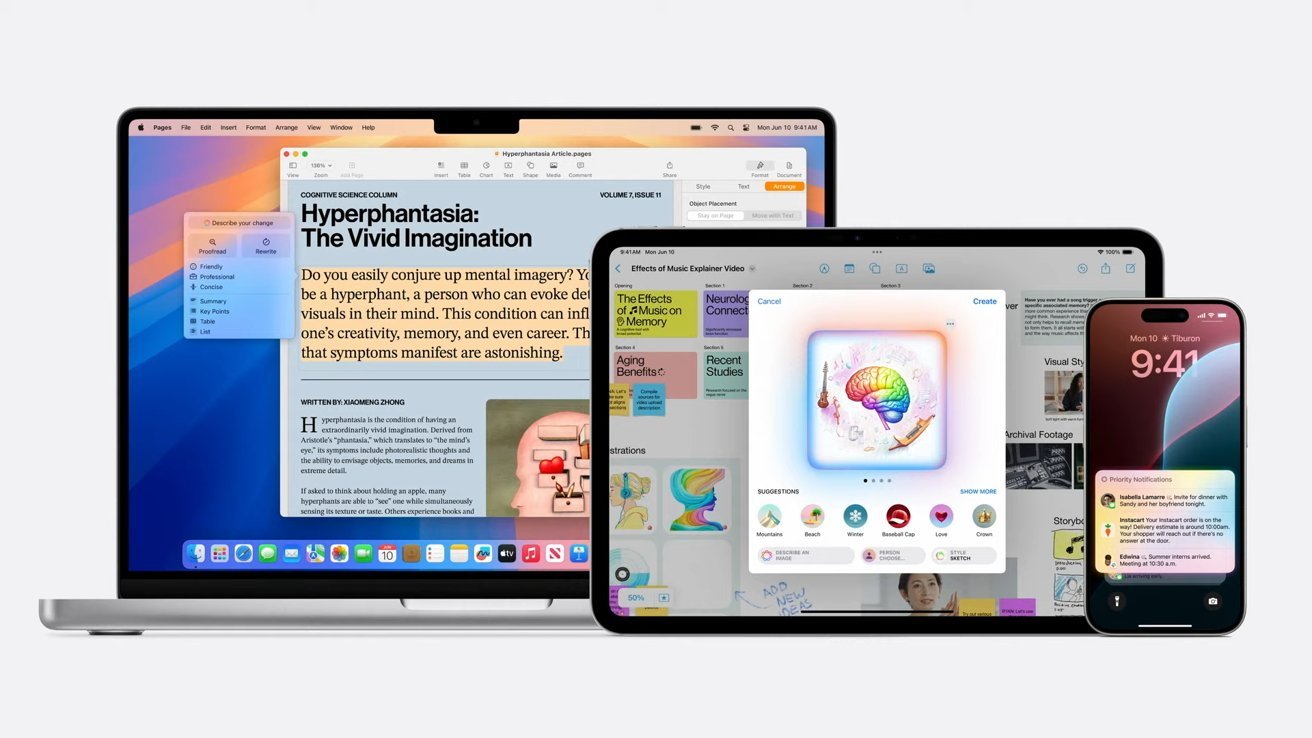Struggling to keep up with emails, Slack messages, and company-wide announcements?
Internal communication can feel like a full-time job—because, for many, it practically is. Between responding to messages, drafting memos, and switching between platforms, these tasks eat up a massive chunk of your workweek.
AI can change that. With the right prompts, AI can help you draft clear, effective messages faster—whether you’re responding to a quick question, announcing a major update, or tackling a sensitive topic.
In this guide, we’ll cover the best AI prompts for internal communications and how —the everything app for work—can help you streamline messaging, reduce back-and-forth, and boost efficiency.
Top AI Prompts for Internal Communications: Boost Engagement & Clarity
⏰ 60-Second Summary
- Internal communications consume a significant portion of work time, with AI offering solutions to streamline and enhance messaging
- AI can personalize employee communications, analyze data, and automate routine messages, improving engagement and clarity
- Effective AI prompts are crucial for impactful internal communications, including company-wide announcements and employee surveys
- Challenges in AI adoption include privacy concerns, aligning with company culture, and maintaining a human touch in communications
- The future of AI in internal communications includes smart message personalization and AI-powered workflow management while maintaining essential human interaction
- AI tools like can generate messages, insights, and strategies, making internal communications more efficient and effective
- Brain integrates AI within your workspace to enhance communication and project management
Ways to Use AI in Internal Communications
Before we get into prompts, here’s how teams are using AI to improve daily chats and company updates:
- Personalize employee communications: Say goodbye to generic messages—AI adjusts tone and delivery based on individual preferences to create engaging employee communications
- Analyze data and measure employee sentiment: AI interprets the trends and sentiment in a company’s recent communication efforts as well as its productivity data, helping managers make informed decisions and enhance team dynamics
- Generate and refine content: AI helps brainstorm ideas, create communication outlines, and turn rough concepts into polished, engaging content
- Automate routine messages: From daily updates to announcements and reminders, AI schedules and personalizes communications to keep employees informed
- Retrieve information instantly: AI quickly finds documents, insights, and citations from connected company data and Google’s vast database with a simple prompt
📖 Also Read: How to Use AI for Productivity
AI Prompts for Internal Communications
Considering its diverse applications, here are the top AI prompts that will make it easier for everyone to craft internal communications.
1. AI prompts for company-wide announcements
Announcements boost employee morale faster than a hit of caffeine dispels Monday blues. They also showcase your commitment to trust and transparency.
Try these three AI prompt examples for impactful company-wide communications:
Launching a new product line
Next month, we’re launching our new product line, [Product Name]. Write a company-wide announcement on how this marks a key milestone for [Company Name] in [Industry/Goal]. Acknowledge employee contributions and encourage them to share their excitement. Keep it concise, engaging, and motivating.

Communicating a shift in the working model
Announce our shift to a [New Working Model] from [Date], outlining in-office and remote work expectations. Highlight the reason, available support, and how it aligns with [Company Name]’s commitment to [Key Value]. Keep it concise, engaging, and motivating, with leadership requesting employee feedback.
Recognizing an award
Announce [Company Name]’s receipt of the [Award Name], recognizing [Reason for Award]. Celebrate the accomplishment, express gratitude to employees, and invite them to a celebratory event on [Date] at [Time], either in-person or virtually. Keep it concise, engaging, and motivating, with a call to action for employees to share their reflections.
💡 Pro Tip: Keep a few AI prompt templates handy with placeholders for events, dates, and milestones—just like we do. When it’s time for an announcement, fill in the details, adjust the wording, and hit send.
2. AI prompts for employee surveys
Feedback is a great way to understand your organization’s needs, especially for containing attrition, boosting engagement, and accelerating growth.
And what’s a better way to collect employee feedback than employee surveys? Here are three AI prompts to maximize its impact:
Preparing a sentiment analysis survey
Create a sentiment analysis survey to gauge employees’ satisfaction with [aspect of the organization]. Include five concise questions covering topics like [specific focus areas]. Use multiple-choice options, Likert scale ratings, and one open-ended question for detailed feedback. Keep the tone neutral, supportive, and encouraging of honest responses.


💡Pro Tip: Use survey topics like a health and wellness challenge to monitor your employees’ overall energy levels.
Motivating employee participation
Write an automated follow-up email from leadership to motivate employee participation in the [Survey Name]. Reassure employees of anonymity, highlight past survey-driven improvements, and include a clickable link to the survey. Encourage completion by [Date] and keep the tone engaging and motivating.


💡 Pro Tip: Add a few insights on survey results, like participation levels, in your prompt. This adds depth and context to your messaging.
Sharing survey results with employees
Write company-wide communication to share key findings from the [Survey Name], including statistics like [Key Results]. Express gratitude for participation, outline planned actions to address feedback, and invite further input for clarity or additional suggestions. Keep the tone appreciative and constructive.


👀 Did You Know? About 21% of employees in the U.S. quit because of workplace culture or politics. Employee surveys help you understand and address these issues before employee turnover derails your organization.
3. AI prompts for measuring internal comms KPIs
Establishing and analyzing key metrics like response times and message open rates helps instantly showcase progress for internal communications.
To measure KPIs with minimal human intervention, consider putting these prompts to use:
Establishing the best internal communication strategies, KPIs, and channels
Share five actionable steps to establish the best internal communication KPIs and select the most effective channels for different employee demographics. Consider factors like [communication tools, employee preferences, engagement levels, and feedback mechanisms]


🧠 Fun Fact: If your prompt requires a long answer, Brain will often create a Doc as a response and share its link with you, instead of returning the answer in the chat window. Talk about efficiency! 🤯
Spotting and preparing for signs of poor-performing KPIs
Identify key indicators and behaviors that signal poor-performing KPIs related to [specific communication or engagement metrics]. Include examples like [behavior indicators], and explain how these might appear in large organizations.


Creating strategies from current KPI status
Share five strategies to improve [KPI Status] from [Current Metric] to [Target Metric] within [Timeframe]. Consider factors like leadership involvement, communication improvements, rewards, team collaboration, and professional development opportunities.


💡 Pro Tip: Attach all relevant reports or details when you ask AI to analyze your KPIs. In-depth information and datasets help AI provide more contextual and accurate responses.
4. AI prompts for creating internal newsletters
Regular broadcasts through internal newsletters become effective outlets for routine updates and educational pieces. Plus, with group email IDs that many businesses already use, newsletters are pretty simple to send out.
Here are a few AI prompts to test for internal comms professionals who need creative ways to create engaging newsletters.
Setting up newsletter templates
Create a monthly internal newsletter template highlighting [Key Topics]. Include sections for [specific sections like CEO message, upcoming events, etc.]. Ensure the tone is celebratory, motivational, and informative.


Creating a newsletter topic calendar
Create a 6-month newsletter topic calendar for [Business Focus]. Provide five monthly topic options, ensuring relevance to upcoming events like [Specific Events/Plans].


Listing design ideas for layouts and visuals
Generate design ideas for a [Number of Pages]-page newsletter layout. Outline article arrangement for readability, suggest modern color schemes, and recommend readable typography with a [Theme Style].


👀 Did You Know? Some AI tools, like Dall-E and SORA, generate not just text but realistic images and videos, too! However, their accuracy might vary. So, it’s best to use them in cases where you’re out of internal assets.
5. AI prompts for leadership communication
Leadership doesn’t stop at making tough decisions; it also involves clearly and impactfully delivering them. From rallying teams and morale to addressing tough calls with empathy, a leader’s words shape the organization’s direction.
If you want to refine your executive messaging, these easy-to-adapt AI prompts help craft stronger internal communications:
Setting the company’s strategic vision
Draft a communication from the [Leadership Team/CEO] outlining the company’s [Strategic Vision] for the next [Timeframe]. Highlight key priorities, core values, and how employees will drive the strategy. Encourage feedback and suggestions.


Sharing the functional team’s achievements
Create a communication recognizing the [Functional Team]’s achievements over the past [Timeframe]. Highlight key successes, including [Specific Achievements], and contributions from other functions like [Supporting Functions]. Mention upcoming initiatives and encourage continued dedication with a personal message from the [CEO/Leadership].


Addressing challenges and crisis management
Draft a transparent and reassuring CEO message addressing current challenges, such as [Specific Challenges]. Acknowledge contributing factors like [Contributing Factors] and outline steps like [Planned Actions]. Inform employees on how they can support and emphasize teamwork, reassuring them about [Key Reassurances]. Encourage open communication and invite feedback.


👀 Did You Know? CEOs influence up to 45% of a company’s performance. Whether it’s getting the most out of board members or employees, communication may very well help hit it out of the park.
6. AI prompts for conflict resolution
While conflict in the workplace is inevitable, how you handle it can make or break the team’s dynamics. From diffusing tension to fostering mutual understanding, the right message can turn a disagreement into a growth opportunity.
Need help navigating tricky situations? These AI prompts help you strike the right tone and keep the peace:
Bridging a communication breakdown between colleagues
Draft a message from a [Supervisor/Manager] encouraging two employees experiencing a communication breakdown to have an open, honest conversation. Emphasize active listening, a safe space for concerns, and offer mediation resources. Highlight the company’s support in resolving the issue.


Handling disagreements in resource allocation
Write a message as the [Role] addressing a conflict between [Team A] and [Team B] over [Resource/Allocation Issue]. Acknowledge both perspectives and propose a meeting to align priorities. Emphasize leadership’s role in ensuring fair resource distribution while keeping [Project Goal] on track.


Requesting for conflict mediation
Draft a request to [Department/Person] for mediation due to ongoing [Issue] that remains unresolved. Ask for guidance on addressing the issue professionally while ensuring mutual respect. Emphasize the importance of a [Desired Outcome] and propose a [Next Step] to assess progress.


7. AI prompts for employee interactions
Meaningful workplace interactions build genuine team connections, making work feel like play.
Here are some AI prompts for unlocking the best interpersonal communication with your team members:
Sharing peer-to-peer recognition for achievements
Write a congratulatory message to my colleague [Colleague’s Name] for successfully leading [Project Name]. Highlight their achievement, its impact on the team or company, and how it contributed to overall success. Keep it personal, express appreciation for their contributions, and offer support for future projects.


Encouraging a team member for an upcoming project
Write a message encouraging [Team member names] from [Department names] to collaborate on [Project Name]. Outline the project’s goals, expected outcomes, and the importance of teamwork. Highlight how their expertise will contribute to success and invite them to share ideas or questions.


Reaching out to a colleague for their expertise
Write a message to [Colleague’s Name] inviting them to share their expertise on [Project/Topic]. Mention the importance of their input, suggest a meeting, and ask for a suitable time.


👀 Did You Know? Work relationships power up to 39% of job satisfaction. Smooth interactions = happier teams! 🤝
Bonus prompt: Retrieving insights and files
Work today is broken.
60% of our time is spent sharing, searching for, and updating information across different tools. Our projects, documentation, and communication are scattered across disconnected tools that drain productivity.
AI work assistants like Brain can help—by fetching your workspace information in seconds. Try the prompt below:
What are the key trends and statistics according to the [Report Name]? Also, pull up the document you’re referring to.


📮 Insight: Only 12% of our survey respondents use AI features embedded within productivity suites. This low adoption suggests current implementations may lack the seamless, contextual integration that would compel users to transition from their preferred standalone conversational platforms.
For example, can the AI execute an automation workflow based on a plain text prompt from the user? Brain can! The AI is deeply integrated into every aspect of , including but not limited to summarizing chat threads, drafting or polishing text, pulling up information from the workspace, generating images, and more!
Join the 40% of customers who have replaced 3+ apps with our everything app for work!
Best Practices for Using AI Prompts
Our prompts cover nearly every workplace scenario, but crafting a top-tier response takes some finesse. Follow these five simple tips to elevate every AI-generated message.
Make it crystal clear
Use clear and specific prompts for more accurate AI responses. The more detail you provide, the better the AI can tailor its answer to your needs. Think about what information matters most and structure your request accordingly.
📌 Example: Avoid vague requests like “Tell me about project updates.”
Instead, try ‘List the key milestones achieved in the Q3 mobile app development project, including completion dates and team members involved.’
💡 Pro Tip: Share examples in your prompt for clearer, more practical responses.
Pack in the right context
One question could have a million answers depending on the story or context. That’s why you need to add context-rich prompts for AI to understand your needs better. Include anything from why you need it to your target audience.
📌 Example: Instead of “Write an internal update about our new policy,” try: “Create a friendly internal update for employees about the new remote work policy, emphasizing flexibility, key guidelines, and how it supports work-life balance.”
Break it down step by step
Do you need to draft a complex question or announcement? Break your AI prompt into smaller, logical chunks.
📌 Example: Start broad with “What are the phases of a product launch?” Then, refine with “Create a list of social media content ideas for launch day.”
Test and tweak
Nailing prompt creation on the first attempt is rare. It’s best to start simple and play around with different approaches. Based on the responses you get, begin tweaking and refining your prompts.
📌 Example: Start with “Write an announcement about the upcoming company event.” Then, based on the response, refine it to “Create an engaging announcement for the upcoming team-building event next Friday, including the schedule, location, and how employees can RSVP.”
Get creative with your approach
While AI could draft the perfect email or report, its quality hinges on your prompt’s creativity. Go beyond basic questions and try role-playing scenarios. Creative prompts lead to fresh perspectives and relatable solutions.
📌 Example: Instead of asking, “Write a sales report for Q1,” try “If you were a sales manager analyzing Q1 performance, what key trends would you highlight, and how would you recommend moving forward?”
You’ve got the message; now, you just need the medium, AKA the right AI tool. But why limit your AI tool to just communication prompts when you could do so much more with it?
With ’s everything app for work, your tasks, projects, knowledge, and collaboration are all enhanced by a powerful, native AI: Brain.


From drafting messages for internal communications to fine-tuning your communication strategies themselves, Brain has got you covered. Access it from anywhere inside —your tasks, docs, and chat—and get context-aware assistance at your fingertips.
Integrated with Docs, Brain’s AI Writer for Work helps you craft case studies, blog posts, and emails within your documents. This is also great for creating communication plan templates and guidelines.
Need a quick breakdown for lengthy documents? Brain’s summarization feature simplifies complex reports in seconds. It even has a dedicated stand-up summary for managers to catch up on priorities and team needs.
Brain is also an excellent knowledge manager, fetching insights, resources, and relevant document links from across your ecosystem (including connected apps) with just a click.
Communication excellence doesn’t stop there. also offers an all-powerful messaging solution, Chat.


Sure, the built-in internal communication solution lets you share information on team, individual, and even company-wide messaging threads. But that’s just the start. It also links each conversation with relevant tasks, projects, and resources for context, so you never have to interrupt your work to communicate.
Its AI-powered summaries simplify lengthy message threads, reducing the effort required to craft effective replies. It even lets you triage valuable insights and turn them into tasks in a snap.
And what about situations where text messages fail to convey the complete context?


You can record your screen and webcam with narration using Clips. It makes crafting tutorials, announcements, and guides a breeze.
Plus, your recordings are easy to share! Embed them into tasks, documents, and even whiteboards within . In fact, when you record a Clip from a chat window or comment thread, it’s automatically attached to the message as soon as you stop recording.
Clips also includes AI-powered transcripts in every video. These reliable transcripts free you from constant note-taking, driving better active listening and understanding.
Yes, other AI communication tools exist, such as ChatGPT, Gemini, and Perplexity AI. While they’re all popular choices for prompt-based responses, none integrate so seamlessly with your work (and workspace) as Brain.
Overcoming Challenges in AI for Internal Communications
AI is powerful, but using it’s not always straightforward. Along with best practices, preparing and tackling a few challenges is crucial. Here’s what to watch out for.
Addressing privacy and security concerns
Data privacy is crucial when using AI for effective internal communications. Breaches or misuse could damage trust and your company’s reputation.
👉🏼 Mitigate these risks by streamlining access controls and protecting sensitive data. Strengthen security with encryption, regular audits, and proper access management to safeguard your information.
Aligning with company culture
Getting AI to fit naturally into your company’s DNA takes some work. It gets especially tough reflecting the employee’s and organization’s vision, mission, and tonality.
👉🏼 Overcoming this requires embracing AI into your company’s growth story. Plus, building an acumen for prompt engineering makes a big difference in the transition.
Managing resistance to change
Change may make people nervous, especially when it involves AI. It often creates the misconception that reducing human effort will reduce humans. Ultimately, there’s rejection or heavy resistance to embracing AI’s potential.
👉🏼 Start highlighting that AI is there to assist, not replace. Once your teams are relaxed, provide training modules to encourage employees to make the best of it.
Balance AI content with the human touch
Without the creative input of a communications expert, AI tools will just end with monotonous messages. As AI reduces the manual effort and brainpower involved in writing, losing the human touch in your final drafts is easy.
👉🏼 Allowing teammates to review your draft is an excellent way to address this. Also, prioritize how you personalize the content that AI generates.
The Future of AI in Internal Communications
AI communication tools transform how teams communicate and stay aligned in the workplace. Along with AI, internal messages will be expected to evolve and expand. But to what end?
Here’s a peek at what the future holds.
Smart message personalization
61% of U.S. companies now use AI to optimize emails, while 55% rely on it to provide personalized services.
AI will move beyond generic messages, using hyper-personalization to tailor content based on each employee’s role, interests, and work style. With advanced natural language processing, businesses will soon easily create messages in local languages, offering every reader a unique experience.
44% of businesses surveyed by Forbes Advisor plan to use ChatGPT to write content in other languages.
AI-powered workflow management
AI tools will optimize timing, ensuring the right message reaches employees at the perfect moment. By tracking engagement and flagging critical updates, AI keeps communication flowing smoothly and ensures no vital message is overlooked.
Evergreen human touch
46% of companies are already using AI to streamline internal communications, plans, presentations, and reports.
Despite AI’s rise, human interaction will remain essential. Building connections, adding context, and fostering open dialogue are irreplaceable elements that will keep teams engaged and connected.
Level Up Your Employee Engagement with
AI reshapes how you respond to messages and an organization’s impact on employee morale. Depending on how impactful your prompt is, AI can even streamline conflict resolution and generate meaningful conversations.
Now, all you need is the right tool. With , you get AI, task management, messaging, analytics, documentation, and 1000+ integrations—all in one platform.
Ready to rewrite your internal communications (pun intended)? Sign up for a free account today!


Everything you need to stay organized and get work done.













